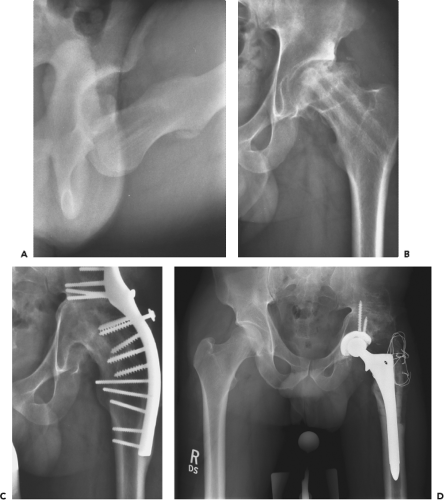Conversion of Hip Arthrodesis to Total Hip Arthroplasty
John J. Callaghan
Steve S. Liu
Case Presentation
36-year old, active male who at age 15 sustained a hip dislocation (Fig. 73.1A) and developed osteonecrosis which was treated with bone grafting. He subsequently developed end-stage degenerative arthritis of the hip (Fig. 73.1B) and underwent a successful hip fusion with a cobra plate (Fig. 73.1C) at age 17. He presented with incapacitating low back pain and underwent conversion of the hip fusion to total hip replacement. Five years later, he has returned to an active lifestyle with pain free range of motion of the hip and no back pain (Fig. 73.1D).
Before the advent of hip arthroplasty and its precursors, hip arthrodesis was the only procedure available for patients with end-stage hip arthritis. Today, with the increase in success of total hip arthroplasty in the young, especially with the success of newer bearing surfaces (1), hip arthrodesis is becoming rarely, if ever, indicated for end-stage hip arthritis. However, with the resurgence of hip arthrodesis in the mid to late 1980s because of the long-term reported success (Table 73.1) (2,3), there are a number of patients who present with the late sequelae of the procedure including incapacitating low back pain, end-stage contralateral hip arthritis, and end-stage ipsilateral knee arthritis. The present chapter will outline operations
around hip arthrodeses and hip arthroplasty conversion to total hip replacement.
around hip arthrodeses and hip arthroplasty conversion to total hip replacement.
Operations Around Hip Arthrodesis and Hip Arthrodesis Conversion to Total Hip Arthroplasty
Our previous editions of the Adult Hip illustrate the various techniques for hip arthrodesis which may be applicable for understanding the nuances of hip arthrodesis conversion to total hip arthroplasty. When patients develop contralateral hip or ipsilateral knee pain after hip arthrodesis, consideration may be given to performing a total hip replacement contralateral to the hip fusion or a total knee arthroplasty below a hip fusion. Although this would not be our recommendation, except in very low demand patients (with less than 5 or 10 years life expectancy), these options have been described (3,5,6). In patients with contralateral total hip arthroplasties, Garvin et al. (5) reported a 40% loosening incidence at 7 years. Liechti (6) reported a 9% loosening incidence at 1 to 8 years in patients undergoing total hip arthroplasty opposite a fused hip. Garvin et al. (5) noted a relative decrease in knee motion compared to primary total knee arthroplasty at 7 years in patients with a total knee replacement on the ipsilateral side of a hip fusion, although stable cement–bone interfaces were reported. Romness and Morrey (3) demonstrated no loosening in 16 knee replacements below well-positioned hip fusions.
Table 73.1 Long-term Results of Hip Arthrodesis | ||||||||||||||||||||||||
|---|---|---|---|---|---|---|---|---|---|---|---|---|---|---|---|---|---|---|---|---|---|---|---|---|
|
In patients with disabling low back pain, ipsilateral knee pain (with end-stage degenerative changes on radiographs), and contralateral hip pain (with end-stage degenerative changes on radiographs), conversion of the arthrodesis to a total hip arthroplasty should be considered (7,8




Stay updated, free articles. Join our Telegram channel

Full access? Get Clinical Tree









